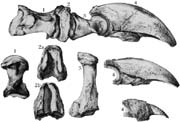Megalonyx
 |
| Bones of the Megalonyx jeffersoni described in a paper by Thomas Jefferson. Courtesy of the American Philosophical Society. |
In his instructions of 1803 to Meriwether Lewis regarding the upcoming expedition up the Missouri River, President Jefferson told Lewis to look for "the animals of the country generally, and especially those not known in the U.S., [and] the remains and accounts of any which may [be] deemed rare or extinct." Though not mentioned by name in the instructions, two animals that Jefferson thought Lewis might find on the western plains were mammoths and an unknown giant "tiger-lion" named Megalonyx by Jefferson himself.
Jefferson is probably best known today for writing the Declaration of Independence and his statesmanship as the third president of the United States. But Jefferson also was an expert in many areas of art, engineering, and science. Among other pursuits, he enthusiastically worked in the then-infant science of paleontology. He had collections of fossil bones that he proudly showed in the unfinished East Room of the White House and later in his home at Monticello. Even while on his way to his inauguration as vice president of the United States in 1796, Jefferson delivered a wagonload of fossils to the American Philosophical Society.
The Megalonyx, or "great claw," was a creature described by Jefferson based on a set of fossil bones he received in 1796. The bones had been found in a cave in Greenbriar County, Virginia (now West Virginia). The fossils included foreleg and forefoot bones, and claws that were eight inches long. Jefferson thought the Megalonyx was a member of the "family of the lion, tiger, panther, etc.," but that it was much larger than any known feline. It turned out that the bones were actually part of a giant, ground-dwelling sloth larger than a full-grown bison. Although Jefferson's initial interpretation was wrong (a common event in a new science), the name of the species was later changed to Megalonyx jeffersoni in honor of his pioneering work.
< previous |



